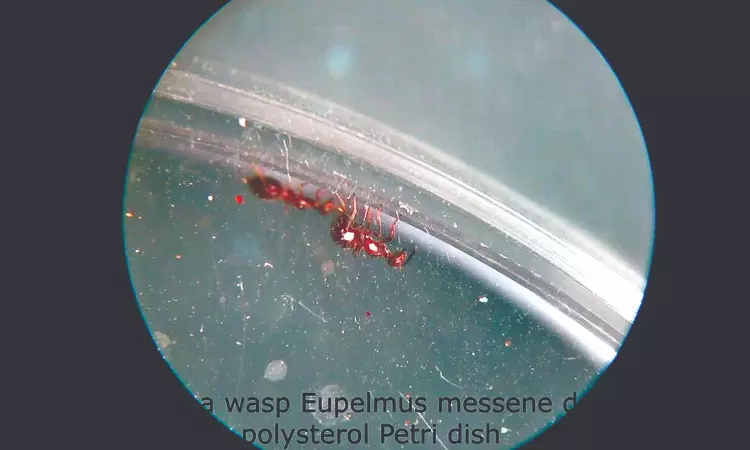Tiny parasitic wasp can drill through plastic
Of the 56 wasps the researchers raised, eight drilled holes in the plastic, including three who did so even though a perfectly good host was sitting in the dish with them.

Eupelmus messene is an eensy arthropod that bores into hardened plant growths, called galls. It has to work harder to break through polystyrene than through a plant gall.
• DARREN INCORVAIA
NEW YORK: By the time Matvey Nikelshparg was 13, he was obsessed with parasitoid wasps, tiny insects that lay their eggs on or inside other bugs. Under a microscope in a lab he had assembled at home, he discovered that one species had a startling superpower: It could use an organ that protrudes from its abdomen to drill through a plastic petri dish. Nikelshparg said his “amazement reached its peak” when he observed that the wasp had not only drilled through the petri dish, but had laid an egg outside of the container that later grew into a healthy adult. The young researcher, who recently started to pursue his bachelor’s degree at Saratov State University in Russia, reported his discovery last month in The Journal of Hymenoptera Research.
Eupelmus messene is a whisper of a wasp. Smaller than a grain of rice, and harmless to humans, this eensy arthropod bores into hardened plant growths, called galls, with an organ called an ovipositor. The insect’s target is the larvae of other wasp species, which lay their eggs inside of galls in an effort to protect them from danger. By piercing its prey’s botanical fortress, E. messene bestows on its young a ready-made meal and, ironically, grants it the same protection from the elements that its target originally sought.
In his experiments at home, Nikelshparg had set out to study what would happen if there were multiple E. messene wasps and only one host larva. He placed one host in a petri dish with 12 females. Most of the wasps immediately scrambled to jab the larva with their ovipositors, he said, “and began pushing and biting each other in a competitive struggle for reproduction.” But one wasp, curiously, chose to stay away from the melee. Nikelshparg saw her opt for a different “host” — the polystyrene wall of the dish itself.
Nikelshparg reported his discovery to his mentors, Vasily Anikin, of Saratov State, Alexey Polilov, of Lomonosov Moscow State University, and his sister Evelina Nikelshparg, also at Moscow State. They raised more wasps in the hope of seeing more plastic drilling.
Of the 56 wasps the researchers raised, eight drilled holes in the plastic, including three who did so even though a perfectly good host was sitting in the dish with them. The boring process could take over two hours, and the wasps would frequently leave their work-in-progress for a lunch or water break before returning to it. One industrious wasp drilled five different holes over the course of the study. E. messene has to work harder to break through polystyrene than through a plant gall. The wasp pushes its ovipositor down while rotating it in both directions, although not quite like the fully circular motion of a power drill. Once it has broken through and laid its egg, the wasp withdraws its ovipositor with “very rhythmic and sharp upward motions,” Nikelshparg said. The so-called ejection movements have never been seen when the parasitoids pierce galls, suggesting “that wasps of this species are indeed flexible in their drilling behavior.”
Uros Cerkvenik, a biologist at the University of Ljubljana in Slovenia, who was not involved with the study, said it was interesting that the wasp could penetrate the smooth petri dish. It’s thought that the wasps normally exploit tiny cracks in a gall’s surface, but the plastic “presumably does not have such cracks,” he said.



